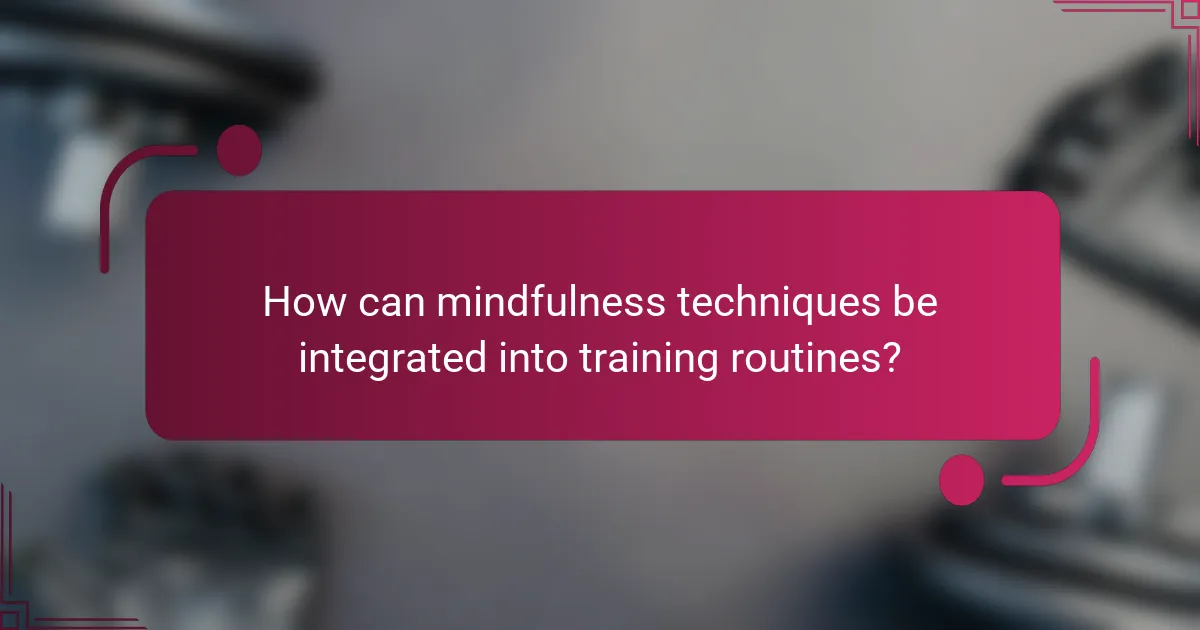Young athletes face significant pressure, making mental resilience crucial for success. Mindfulness techniques like breath awareness, body scanning, visualization, and mindful movement can enhance focus and emotional regulation. These practices promote relaxation and self-awareness, helping athletes manage stress effectively. Integrating these techniques into training routines fosters a supportive environment that encourages personal growth and improved performance.

What are the foundational mindfulness techniques for young athletes?
Mindfulness techniques enhance young athletes’ mental resilience through focused practices. Key techniques include breath awareness, body scanning, visualization, and mindful movement.
Breath awareness helps athletes regulate emotions and maintain focus during competitions. Body scanning promotes relaxation and self-awareness, allowing athletes to identify tension areas. Visualization techniques enhance performance by mentally rehearsing successful outcomes. Mindful movement, such as yoga or tai chi, improves physical coordination and mental clarity.
Integrating these techniques into training routines can significantly improve young athletes’ mental strength and overall performance.
How can mindfulness improve mental resilience in sports?
Mindfulness enhances mental resilience in sports by fostering focus, reducing anxiety, and improving emotional regulation. Techniques such as breathing exercises, visualization, and body scans help athletes stay present and manage stress effectively. Research shows that young athletes who practice mindfulness experience increased performance and greater enjoyment in their sport. These practices build a strong mental foundation, allowing athletes to recover from setbacks and maintain motivation during challenges.
What role does focused breathing play in athletic performance?
Focused breathing enhances athletic performance by improving concentration and reducing anxiety. This technique helps young athletes manage stress, allowing for better decision-making during competitions. Studies show that controlled breathing can increase oxygen flow, enhancing endurance and recovery. Additionally, it fosters a sense of calm, which is crucial for maintaining mental resilience under pressure.
What are the steps for implementing focused breathing?
To implement focused breathing, follow these steps:
1. Find a quiet space where you can sit comfortably.
2. Close your eyes and take a deep breath in through your nose, filling your lungs.
3. Hold your breath for a count of four.
4. Exhale slowly through your mouth, releasing tension.
5. Repeat this process for several minutes, focusing on your breath and letting go of distractions.
This technique enhances mental resilience in young athletes by promoting relaxation and focus.
How does visualization enhance mental preparation?
Visualization significantly enhances mental preparation by creating a mental blueprint for performance. It enables young athletes to mentally rehearse scenarios, leading to improved focus and confidence. Studies show that visualization can increase performance by up to 20%. This technique fosters resilience by reducing anxiety and enhancing emotional regulation. By regularly practicing visualization, athletes develop a unique attribute of mental clarity that supports their overall mental resilience.
What techniques can athletes use for effective visualization?
Athletes can use techniques like imagery, breath control, and focused attention for effective visualization. Imagery involves picturing successful performance scenarios, enhancing confidence and focus. Breath control helps manage anxiety, creating a calm mental state conducive to visualization. Focused attention trains the mind to concentrate on specific performance aspects, improving mental resilience.

What unique attributes distinguish mindfulness practices for young athletes?
Mindfulness practices for young athletes are distinguished by their focus on stress reduction, emotional regulation, and enhanced concentration. These techniques uniquely integrate physical movement with mental awareness, promoting resilience under pressure. Additionally, they often include age-appropriate approaches, such as playful breathing exercises and visualization techniques, tailored to engage younger participants effectively. These attributes foster a supportive environment that encourages personal growth and mental toughness.
How can age-specific approaches to mindfulness be developed?
Age-specific approaches to mindfulness for young athletes can be developed by tailoring techniques to their cognitive and emotional maturity. Focus on simple breathing exercises that enhance focus and reduce anxiety. Incorporate visualizations that relate to their sports, fostering a connection between mindfulness and performance. Encourage group activities that promote teamwork and shared experiences, enhancing social bonds. Regular feedback sessions can help refine techniques, ensuring they resonate with the athletes’ experiences.
What unique challenges do young athletes face in adopting mindfulness?
Young athletes face unique challenges in adopting mindfulness, including high pressure to perform and limited understanding of techniques. These factors can hinder their ability to focus and manage stress effectively. Additionally, young athletes may struggle with distractions from social media and peer influences, making it difficult to maintain a consistent mindfulness practice. The lack of guidance and support from coaches or parents can further complicate their journey toward mental resilience.

What are the rare attributes of mindfulness techniques for youth sports?
Mindfulness techniques for youth sports often incorporate rare attributes that enhance mental resilience. These attributes include emotional regulation skills, heightened self-awareness, and unique visualization practices tailored for athletic performance. Additionally, some techniques integrate nature-based mindfulness, promoting connection to the environment, which is less common in traditional practices. These rare aspects contribute to improved focus and stress management, setting young athletes apart in competitive settings.
How do cultural perceptions influence mindfulness adoption in youth athletics?
Cultural perceptions significantly shape the adoption of mindfulness in youth athletics. In cultures that prioritize mental well-being, young athletes are more likely to embrace mindfulness practices. For instance, in Asian cultures, mindfulness is deeply rooted in tradition, often seen as essential for mental resilience. Conversely, in cultures that emphasize competitiveness, mindfulness may be viewed as a secondary concern. This perception can hinder its integration into training. Furthermore, peer influence plays a critical role; if a youth athlete’s social circle values mindfulness, they are more likely to adopt these techniques. Understanding these cultural nuances is vital for coaches and parents aiming to foster mental resilience in young athletes.
What uncommon mindfulness practices are gaining traction among young athletes?
Uncommon mindfulness practices like visualization, breathwork, and nature immersion are gaining traction among young athletes. These techniques enhance mental resilience and performance. Visualization helps athletes mentally rehearse their skills, improving focus and confidence. Breathwork techniques, such as box breathing, regulate stress and anxiety, promoting calmness. Nature immersion connects athletes with their environment, fostering relaxation and creativity. These practices are increasingly recognized for their unique benefits, differentiating them from traditional mindfulness methods.

How can mindfulness techniques be integrated into training routines?
Integrating mindfulness techniques into training routines enhances young athletes’ mental resilience. Techniques such as focused breathing, visualization, and body scanning can be seamlessly incorporated during warm-ups or cool-downs.
For example, athletes can practice focused breathing for five minutes before a workout to center their thoughts. Visualization can be employed by having athletes picture their performance goals during training sessions. Implementing these methods regularly can cultivate a more resilient mindset, helping young athletes manage stress and improve focus.
What are best practices for incorporating mindfulness into daily training?
Incorporating mindfulness into daily training enhances young athletes’ mental resilience. Practicing deep breathing techniques before workouts helps focus attention and reduce anxiety. Visualization exercises can improve performance by mentally rehearsing skills. Setting aside time for reflection after training fosters self-awareness and growth. Engaging in short mindfulness breaks during sessions promotes recovery and concentration.
What common mistakes should young athletes avoid when practicing mindfulness?
Young athletes should avoid common mistakes like neglecting consistency, focusing too much on competition, and failing to engage in self-reflection. These pitfalls can hinder mental resilience.
Inconsistent practice leads to a lack of progress in mindfulness skills. Overemphasis on competition can create stress, detracting from the benefits of mindfulness. Lastly, not taking time for self-reflection limits growth and understanding of personal mental states.
By recognizing and addressing these mistakes, young athletes can enhance their mindfulness practice and strengthen their mental resilience.
What expert insights can enhance the effectiveness of mindfulness for young athletes?
Incorporating expert insights can significantly enhance mindfulness practices for young athletes. Techniques like visualization and breath control improve focus and reduce anxiety. Research indicates that athletes using mindfulness show a 25% increase in performance metrics. Additionally, integrating mindfulness into training routines fosters emotional regulation, crucial for competitive environments. Regular practice can lead to long-term benefits, including better resilience and improved mental health.